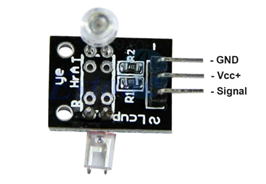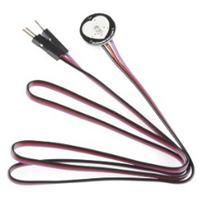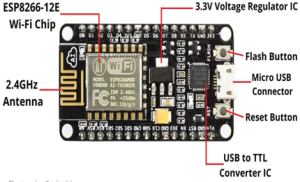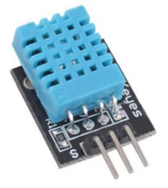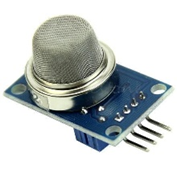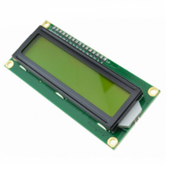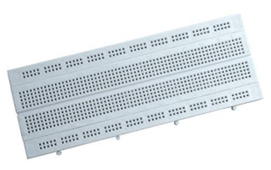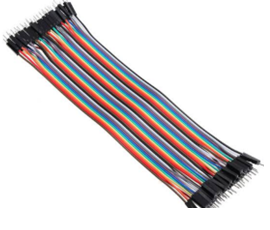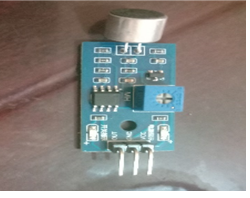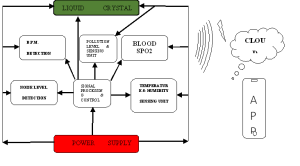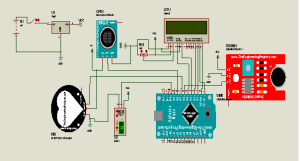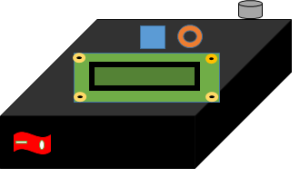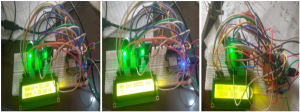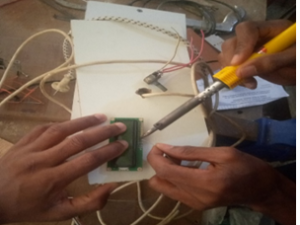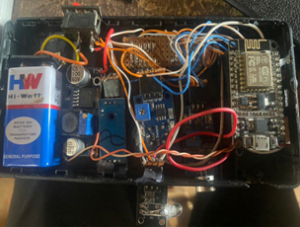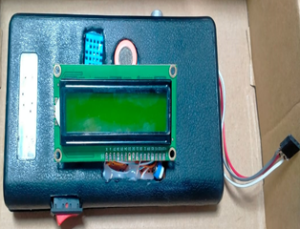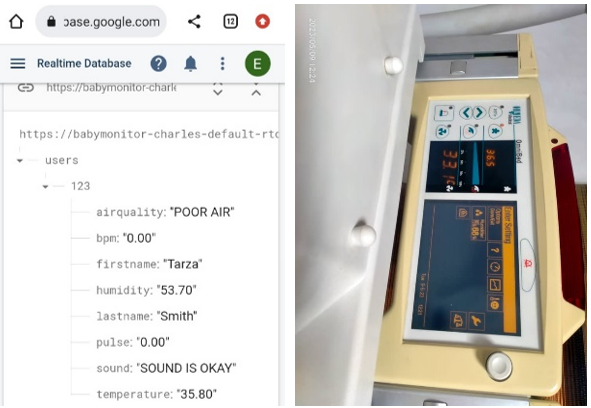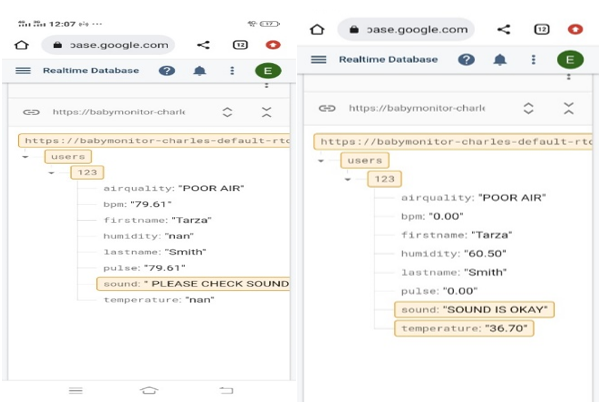Real-Time Monitoring of Neonatal Incubator Parameters Via Iot-Integrated Device: Design, Implementation, And Evaluation
- Mbanuzue C.E
- Hassan O.E
- Owolabi F.M
- 127-143
- May 4, 2024
- Environmental Impact
Real-Time Monitoring of Neonatal Incubator Parameters Via Iot-Integrated Device: Design, Implementation, and Evaluation
*Mbanuzue C.E, Hassan O.E, Owolabi F.M
Department of Biomedical Technology, Federal University of Technology Akure, Ondo State.
*Corresponding Author
DOI: https://doi.org/10.51584/IJRIAS.2024.90409
Received: 08 March 2024; Revised: 25 March 2024; Accepted: 30 March 2024; Published: 04 May 2024
ABSTRACT
The Internet of Things (IoT) has revolutionized healthcare solutions’ design, construction, and deployment. This research project focuses on developing an external device incorporating Internet of Things (IoT) technology for real-time monitoring of neonatal incubator parameters in sub-Saharan Africa. This IoT is intended to monitor real-time vital signs such as body temperature, humidity, pulse rate, oxygen concentration, air quality, and the sound level of the immediate environment and transmit the data via a mobile application. The Internet of Things has a micro controller for storing temporal sensor data. Temperature, humidity, and heart rate sensors monitor temperature, humidity, pulse oximetry, and heart rate, respectively, and a gas sensor detects harmful gases. The mic sensor detects abnormal sound levels around the incubator, while the Wi-Fi module provides the micro controller access to a Wi-Fi network. The sensor data is sent to a cloud-based platform that houses the data, analysis, and retrieval. This research paper contains the details of system design, implementation, and performance evaluation. The evaluation findings reveal the device to be trus table and accurate, providing neonate caregivers with valuable information.
Keywords: Neonates, IOT, infant incubator, sensor, Node Micro-controller
INTRODUCTION
The Internet of Things (IoT) is undoubtedly influencing many aspects of life, including medical equipment design and development. A neonatal incubator is undoubtedly a prime candidate for ease of implementation when it comes to applying IoT in medicine.
The Neonatal Intensive Care Unit (NICU) is a hospital that offers critical medical care for neonates. Prematurity is one of the leading causes of admission of neonates and preterm infants in the NICU. An infant who weighs less than 2.495 kg or any medical condition that requires special care and deliveries before the 37th gestational week are premature or preterm infants [1]. Every year globally, about 15 million neonates are delivered preterm. This figure represents more than 10% of the prevalence of infants. Based on the WHO data, every year, on average, preterm birth complications lead to the death of approximately one million infants [2]. Many individuals who have gone through traumatic experiences tend to have a chronic disability that will persist even in their lifetime that includes but is not limited to, cognitive deficit and visual and auditory impairment. In 2022, Nigeria’s infant mortality rate was 56.68 per thousand live births. According to the Statistical data presented in “Nigeria: Based on the “Infant Mortality Rate 2022” [3], this is 56.00 infant deaths per 1,000 live births. Accordingly, the rates need to be brought down.
The NICU has new equipment that can check a newborn’s condition, like oxygen level, pulse rate, body temperature, and blood pressure. During the last few years, the capacity of the healthcare industry to use IoT has dramatically increased [1]. They have been used to monitor vital signs such as patients’ blood pressure and pulse rate. Recent demonstrations in IoT-based systems have shown that they can provide higher levels of patient care and monitoring as they use real-time data to manage certain operations automatically and detect early signs of disease [4].
Meanwhile, leveraging IoT tools in adult medicine is common practice, though the field of newborn care needs more research. Infants are more vulnerable and have higher chances of various health problems; therefore, neonatal medicine is a subject of medicine that has particular importance. A newborn incubator, which is IoT-based, would allow healthcare professionals to track and analyze important metrics related to the patient’s physiological state. The doctors can have real-time information, and they can diagnose diseases even at the onset, which improves the quality of neonatal care.
The development of the IoT-based newborn incubator is challenging. It requires the integration of several technologies like sensors, Arduino, and communication protocols. The system must also be built with safety in mind, as a fault or malfunction can also harm the newborn [5].
This research paper focuses on the current technological stage and a developed IoT-based newborn incubator device. Moreover, it investigates the design and development of such an incubator and the potential benefits it may offer for healthcare providers and newborns.
AIM AND OBJECTIVES
This study aims to design a Real-Time Monitoring of Neonatal Incubator Parameters Via IoT-Integrated Device: Design, Implementation, and Evaluation.
The specific objectives are:
- Creating a wireless sensor system operating on IoT technology and positioning it outside neonatal incubators to monitor incubator parameters in real-time.
- To use modern technologies, including cloud computing and artificial intelligence, where data can be accessed remotely and automatic data collection can be achieved.
- To build a user-friendly interface that allows healthcare personnel and parents or guardians to easily control and view the data.
- To build a cost-effective and efficient device widely perceived as a solution for healthcare so that it is commonly accepted and used by hospitals or other medical settings.
- Consider including this device in medical devices and support systems.
MATERIALS AND METHODS
Materials Used
The materials that were used for this project are categorized into two:
- The Software components and,
- The Hardware components
The Software Components
These are the software components used in the design of this project:
Firebase
Firebase is a platform that allows mobile and web application developers to access a bundle of instruments and services for building, testing, and deploying applications.
Firebase’s real-time database functionality rates are among its most essential features, as it allows for real-time data synchronization across different devices and platforms. This can be an advantage for programs with real-time updates, whether they are communication or collaborative work tools.
In addition to its basic functionalities, Firebase offers additional services such as cloud messaging, which enables message and notification transmission to users across multiple platforms. The production of authentication services provides a convenient way for developers to seamlessly construct their apps with user authentication and authorization.
Also, Firebase provides cloud storage solutions for user-generated content and application data, along with hosting facilities that enable web applications to be deployed. Moreover, these functions include analytics, crashing, and A/B testing [6].
Arduino IDE
Arduino is a user-friendly and open-source platform for creating electronic creations. It comprises a programmable hardware circuit board (microcontroller) and an Integrated Development Environment (IDE). This application is used to write and upload computer code to a physical board. According to [7], the programming language used by the Arduino IDE is a simplified version of C++, which makes the programming process easier to understand. The Arduino IDE was used to write and upload code to the NODE Micro controller.
Microsoft Excel
The Hardware Components
Listed below are the hardware components used in this project:
Finger heartbeat sensor
Finger Heartbeat Sensor (KY-039) (Sensor Wiki: KY-039 Heartbeat Sensor, 2023)
The KY-039 heartbeat sensor is a compact, portable device that measures a person’s pulse or heartbeat. It detects the finger’s pulse with an infrared LED and a photo transistor. When a finger is placed between the LED and the photo transistor, the photo transistor detects the light emitted by the LED and displays the heartbeat signal on the analogue output pin. This sensor has three pins: S (analogue output signal), VCC (module power), and GND (module ground). It can be readily attached to an Arduino or other micro controller to read and analyse heart rate data.
Heart pulse sensor
Heart Pulse Sensor – SEN-11574 (Spark Fun Electronics, 2023)
Photoplethysmo graphy is a technique for monitoring a patient’s pulse rate. The Heart pulse sensor (SEN-11574) was chosen for this assignment since it is tiny and can be worn or wrapped around the index finger or earlobe.
This sensor module includes a photo detector and infrared LEDs. The idea is based on optical sensing of changes in blood volume. Changes in light intensity are used to monitor changes in blood volume, which is exceptionally beneficial in cardiac systems. During the cardiac cycle, the NODE Micro controller converts the sensor module’s output voltages to beats per minute.
Node Micro-controller ESP 8266
ESP 8266 Node Micro controller (https://www.quora.com/How-do-I-send-data-from-one-MCU-board-to-other-MCU-boards)
The ESP 8266 is a system-on-chip module that allows micro controllers to connect to Wi-Fi networks using the TCP/IP stack. It can also give networking features through other application processors. This module’s firmware and AT command interface have already been installed. This module will send the Arduino board’s message to the server over the Internet. DHT11 (Temperature and Humidity Sensor)
DHT 11 sensor (www.wyhhx.com, 2023)
DHT 11 Sensor
Monitoring the environment requires measuring the temperature and humidity. The DHT11 sensor is the one utilized for these characteristics to simplify the design. The DHT11 sensor, which consists of a capacitive humidity sensor to measure relative humidity and a thermistor to monitor temperature, is essential. This sensor produces a digital signal with the temperature and humidity detected. The highly low-cost sensor’s specifications state that it requires an input of 3-5 volts and a maximum current of 2.5 mA for conversion. It is appropriate for 20–80% humidity levels and has a 5% variability in humidity readings. It can also handle temperature readings between 0 and 50 degrees Celsius with an error of ±2%. DHT11 can sample at a maximum rate of one sample every second. Nevertheless, the logging duration in this design is set to once 45 seconds.
MQ2 (Gas Sensor)
MQ-2 Gas sensor (Mq 2, Gas Sensor Module, 2023.)
The MQ-2 Gas Sensor is a smoke-sensitive device that can identify combustible gases like LPG, butane, propane, alcohol, and methane. The MQ smoke sensor series includes an electro chemical sensor and a tiny internal heater. MQ2 gas sensors can be used indoors at room temperature since they can detect various gases at concentrations ranging from 200 to 10,000 parts per million.
Thanks to its digital pin, this sensor can function without a microprocessor for a single type of gas detection. The analogue pin is TTL-driven and operates on 5V; thus, it can be used with most micro controllers to measure gas in parts per million. The potentio meter integrated into this sensor controls the digital output threshold, which in turn controls the overall sensitivity of the sensor.
LCD 1602
LCD 1602 (LCD 1602, 2023)
The LCD 1602 display uses a dot matrix of 5×7 or 5×11 to display characters, numerals, and letters. Only one character can be displayed at a time, with a space between lines and dots between each pair of characters. The LCD 1602 and Arduino can be linked using a parallel or I2C interface. The contrast level can be changed by connecting a potentio meter to the Vo pin, and a resistor connects the LED+ pin to the VCC. The LCD 1602 runs at 5V and draws about 1 m A of current without a back light.
Breadboard
Breadboard (https://www.amazon.in/Robocraze-Breadboard-800-Points-034/dp/B073B4WQZC)
Electronic components (transistors, resistors, chips, etc.) that are wired together are held on a thin plastic board. It is employed in developing electronic circuit prototypes and is reusable for subsequent projects.
It comprises spring clip contacts, usually placed in matrices with specific blocks of connected clips.
Specifications and Features
- Two distribution strips, with wire sizes ranging from 21 to 26 AWG.
- Tie points total 200.
- A 1000-volt AC standing voltage is used.
- There are 630 tiles within IC.
- DC 500V or 500MQ is the insulation resistance.
- Size is 6.5 * 4.4 * 0.3 inches.
- 5 amps in rating, the temperature at which ABS plastic begins to warp is 138°F (84°C).
- 54 mm is the hole or pitch style.
Jumper wire Male-male
Jumper wires (Jsumo.com/male-to-male-flat-dupont-cable)
Jumper wires are wires with connector pins on each end that can be used to connect two places without the use of solder.
The male connector is a “plug” with a solid pin for centre conductivity.
The female connector, a Jack, has a centre conductor with a hole to accommodate the male pin.
Sound detector module (LM 393)
Sound Detector Module (LM 393)
The sound level is monitored with a sound sensor, LM 393. This device comprises two voltage comparators that work independently. A microphone detects sound and feeds it into the LM393 op-amp, which has an integrated potentio meter for adjusting the sound intensity. When the sound level rises above the threshold, an LED on the module glows, and the output is turned off. When the sensor detects sound, the output signal voltage is processed and sent to the NODE MCU.
Voltage Regulator
The output voltage is kept constant using a voltage regulator integrated circuit (IC).
- Specifications
The input voltage ranges from 7 to 35 volts with a 1 amp (Ic) current rating.
The maximum output voltage is 5.2 volts, and the minimum output voltage is 4.8 volts.
- Applications of Voltage Regulator (IC 7805)
IC 7805 is used in a wide range of circuits. Some of the more significant ones are fixed output regulators, positive voltage regulators in negative voltage configurations, adjustable output regulators, current regulators, adjustable DC voltage regulators, regulated dual supplies, output polarity-reversal protection circuits, and reverse bias projection circuits.
Block diagram of the proposed system
Figure: Block diagram of the Prototype
The system has three main components: an IoT-based hardware module, a web and database subsystem, and remote monitoring applications (see Figure). The hardware module has been designed to collect data independently from various sensors, including biosensors and environmental monitoring devices. The data is then processed on the micro controller board and sent to a database server via the Internet. In this architecture, data communication is carried out via a Wi-Fi communication module. The web and database subsystem comprises two major components: an application programming interface (API) that facilitates data exchange and a data processing module. In the introduction, simple PHP scripts are used to receive and store the data sent by the hardware module in a specified database table. The hardware module can register and initiate communication with the database. Applications for remote monitoring let users access processed data in real-time through mobile apps on Android-powered devices.
System Design
This section describes the system’s design in detail, including the components and sensors utilized by this device. The objectives of the design are as follows: The system must acquire data from all sensors (biosensors and environment monitoring sensors) and send it to a database server.
Environmental sensors detect and measure conditions such as temperature, humidity, sound, light, barometric pressure, water level, and air pollutants. They monitor the environment in several contexts, including indoor and outdoor air quality, industrial processes, agriculture, and research [8].
Environmental sensors include Node Micro-controller ESP8266, DHT11 Sensor, Sound detector module, and LM393 Mic Sensor.
Biosensors are analytical instruments that detect and quantify the presence of a specific substance or analyte in a sample by employing a biological recognition element and a physicochemical detector. Among other applications, they are extensively utilized in biomedical diagnosis, point-of-care monitoring, environmental monitoring, food control, drug discovery, and biomedical research [9].
Finger heartbeat sensor and Heart pulse sensor are examples of Biosensors.
Pin Description
PIN Pin name Description
1 VCC +5v power supply
2 GND Ground (-) power supply
3 OUT Digital Output (0 or 1)
Circuit diagram of the Device
Design Prototype of an External Device for Neonatal Incubator
Due to its lightweight and ease of shaping, plastic is used in the design prototype of an external device for neonatal incubators, making it an ideal material for designing and implementing simple shapes that fit the incubator perfectly.
In the healthcare industry, where hygiene is of the utmost importance, plastic is essential since it is durable and easy to clean, which is crucial for sterilization. It is also an affordable material, making it cost–effective to produce.
Using plastic material for external devices in neonatal incubators offers practical advantages that can improve patient outcomes, streamline healthcare processes, and reduce costs.
Design prototype of an external device for neonatal incubator
RESULTS
The IoT –Enabled external device for enhancing neonatal incubator monitoring and care: Design, implementation, and performance evaluation were successfully achieved as follows:
Coupling of The Various Sensors Node Micro-Controller on Breadboard
Connection of various sensors and Node MCU on Breadboard
Soldering of The Various Sensors on Vero Board and Arrangement of Components Inside the External Device
Soldering of the connector to the LCD using soldering iron and led.
Careful arrangement of components inside the external device
Careful arrangement of the sensors, bulk converter, battery and Node MCU in the external device.
The procedure for connection was done accordingly:
The 9-volt battery has two ports: the positive pin is connected to the switch positive pin, and its negative pin is connected to the bulk converter IN (-).
The switch’s other pin was connected to the bulk converter IN (+).
The bulk converters OUT (+) and OUT (-) were connected to the Node MCU Esp 8266 Vin and GND.
The LCD pin numbers D7, D6, D5, D4, EN, and RS were connected directly to pins D0, D1, D2, D3, D4, and D5, respectively, on Node MCU Esp 8266.
The DHT 11 sensor signal pin was connected to pin D10, the sound detector module out pin was connected to pin D6, the MQ2 D0 pin was connected to the D8, the KY-039 signal pin was connected to the D7 with their ground, and the VCC pin was connected to the ground and Vin pin of the Node MCU.
to D7 with their ground and VCC pin being connected to the ground and Vin pin of the Node MCU.
An IoT-Enabled external device
Admin User Interface
The following steps are taken to navigate the Firebase Admin User Interface:
- Log in to the Firebase account at the Firebase console website (console.firebase.google.com).
- After logging in, the Firebase console dashboard opens. This is the main page where the app “Baby Monitor” can be accessed.
- The project overview is on the menu bar in the left-hand corner. It shows the different firebase sections.
- Clicking on the “see all features” option fills the entire section, and the “real-time database” is clicked. The real-time database provides and syncs data in real time.
- Then click on the “real-time database,” which directs to a dashboard showing the “users’ icon.”
- Clicking on the “user’s icon” opens the “123” tab, which displays the results in real- time.
COMPARISON OF RESULTS
Here, the data uploaded by an IoT-enabled external device to a real-time Firebase is compared to the data shown by the OHMEDA neonatal incubator.
The performance evaluation of the IoT-enabled external device for enhancing neonatal monitoring and care shows that the temperature, sound detector, and gas sensors are working very well. However, the humidity data is not as close as the temperatures, and the heartbeat sensor could not be used on a neonate because we have no neonates admitted to the NICU.
User interface of the Baby Monitor APP
Tabular And Graphical Representation of the Temperature and Humidity readings Of Ohmeda Incubator And The Iot Prototype.
Table 1: Readings of OHMEDA Incubator and IOT device measuring Temperature (0C)
| S/N | OHMEDA INCUBATOR TEMP(0C) | PROTOTYPE TEMP(0C) |
| 1 | 36.50 | 36.70 |
| 2 | 36.20 | 35.80 |
| 3 | 36.30 | 36.30 |
| 4 | 36.50 | 36.50 |
| 5 | 36.40 | 35.90 |
Graph 1: Comparison chart between OHMEDA incubator and the prototype Temperature level
Table 2: Readings of OHMEDA Incubator and IOT device measuring Humidity (%)
| S/N | OHMEDA INCUBATOR HUMIDITY (%) | PROTOTYPE HUMIDITY (%) |
| 1 | 68.00 | 60.50 |
| 2 | 60.00 | 57.50 |
| 3 | 60.00 | 53.70 |
| 4 | 65.00 | 62.30 |
| 5 | 70.00 | 68.50 |
Graph 2: Comparison chart between OHMEDA Incubator and the Prototype (Humidity level)
Descriptive Statistics
| Method | N | Mean | Std. Deviation | Std Error Mean | |
| Temperature | OHMEDA Incubator | 5 | 36.38 | 0.1304 | 0.0583 |
| Prototype | 5 | 36.24 | 0.3847 | 0.1721 | |
| Humidity | OHMEDA Incubator | 5 | 64.60 | 4.5607 | 2.0396 |
| Prototype | 5 | 60.50 | 5.5335 | 2.4747 |
Independent Sample T-test
An independent sample t-test was performed to investigate whether a significant difference exists between the prototype and the incubator’s average temperature and humidity readings. This will identify deviations or possible errors in the readings. The homogeneity of variance assumption was met in the case of humidity values (F = 0.019, p = 0.894). However, this still needs to be met for Temperature, which was corrected in the SPSS output.
There was no significant difference in the mean humidity (t = 1.279, df = 8, p = 0.237, d = 0.809) and the mean temperature (t = 0.771, df = 4.907 p = 0.476, d = 0.487) recorded by the incubator and the prototype
DISCUSSION
This study uses an IoT-integrated external device to present a real-time monitoring system for neonatal incubator parameters. The device was developed, tested, and evaluated for performance testing. This study attempted to resolve the problems of costs and lack of components in resource-limited areas by applying an embedded IoT system to establish a link between the doctor, the incubator, and the mother. The work expands on the existing literature, which assists in advancing the implementation of Internet of Things (IoT) systems in incubators to enhance their design and efficiency.
The review of literature in this article focuses on some design advances in neonatal incubators which include temperature control systems that are efficient and intelligent control systems that utilize the Internet of Things devices. Sahoo et al. (2014) [10] design of an incubator with wireless alert transmission to a nursing station for neonatal care was presented with the objective of eliminate the unnecessary labour of nursing staff. This experiment was conducted utilizing a temperature sensor called DHT 11 where the temperature was regulated inside the incubator.
The paper by Kshirsgar, et al. (2019) [11] shows how temperature can be monitored on multi-purpose and Neo-Natal incubators. This incubator used a DHT11 sensor that did temperature and humidity sensing. Heartbeat & respiration sensors were attached to monitor the infant’s heartbeat & respiratory rate and the device was connected to Wi-Fi to have remote monitoring & control of the surrounding atmosphere.
The study in which the papers of Fahmi et al. (2020) [12] were presented was on an internet-based prototype of infant incubator monitoring system having a range of components and sensors, such as biosensors, environment monitoring sensors, sound sensors, LCD, and speaker. A case study took advantage of a firebase to transmit the data to the server, and mobile applications for the readings of different monitoring parameters.
The 30 dB level was set as a threshold, which exceeds the safe sound for human hearing. The normal breathing gas mixture contains only the inhalation of oxygen and the exhalation of carbon (IV) oxide however presence of other gasses is considered harmful and was sensed by the sensor. The graph displayed on the previous page demonstrates the consistency of the data obtained from the device and the commercial incubators.
The study results are optimistic and indicate that IoT devices can be complemented with incubators and can transmit accurate time information related to monitoring newborns. The research may lead to the reduction of neonatal incubators’ costs and enhancement of their performance which is one of the core factors for success in such a resource-limited condition. The research calls for additional research and a more successful incubator design.
CONCLUSION
Employing IoT-enabled external devices that make real-time monitorization of neonatal incubator parameters possible has demonstrated an elevated level of safety in modern neonatal care. This allows remote monitoring and reset of incubator parameters and consequently minimizes the workload of caretakers and makes the care delivery process more efficient. These experimental results show the design validity and successful integration of an IoT external device for online monitoring and control of parameters of preterm infant incubators. The device’s performance was assessed and it was found to have the ability to maintain the accepted incubator parameters accuracy at the desired ranges.
RECOMMENDATION
The present study findings are an addition to the growing knowledge of the use of IoT systems in neonatal care which also suggests that future research on this topic is warranted. Designing and launching this kind of system can result in a better neonatal care, with a lower risk of neonatal death.
CONFLICT OF INTEREST
The author declares no conflict of interest
DATA AVAILABILITY STATEMENTS
The data and codes that support the findings and development of this study are available from the corresponding author, upon reasonable request.
REFERENCES
- Rajalakshmi, A., Sunitha, K.A. and Venkataraman, R. (2019). A Survey on Neonatal Incubator Monitoring System. Journal of Physics: Conference Series, 1362(1), p.012128. https://doi.org/10.1088/1742-6596/1362/1/012128.
- Perin, J., Mulick, A., Yeung, D., Villavicencio, F., Lopez, G., Strong, K.L., Prieto-Merino, D., Cousens, S., Black, R.E. and Liu, L. (2021). Global, regional, and national causes of under-5 mortality in 2000–19: an updated systematic analysis with implications for the Sustainable Development Goals. The Lancet Child & Adolescent Health, 6(2). https://doi.org/10.1016/s2352-4642(21)00311-4.
- Nigeria: infant mortality rate 2022. (2022). Retrieved from Statista website: of Things and Cloud Computing for Healthcare. Electronics, 8(7), 768.
- Dang, L. M., Piran, Md. J., Han, D., Min, K., & Moon, H. (2019). A Survey on Internet
- Firmansyah, R., Widodo, A., Romadhon, A. D., Hudha, M. S., Saputra, P. P. S., & Lestari, N. A. (2019). The prototype of infant incubator monitoring system based on the Internet of Things using Node MCU ESP8266. Journal of Physics: Conference Series, 1171, 012015. https://doi.org/10.1088/1742-6596/1171/1/012015
- Khawas, C., & Shah, P. (2018). Application of firebase in android app development-a study. International Journal of Computer Applications, 179(46), 49-53.
- Arduino, S. A. (2015). Arduino. Arduino LLC, 372.
- Ho, C., Robinson, A., Miller, D., & Davis, M. (2005). Overview of Sensors and Needs for Environmental Monitoring. Sensors, 5(1), 4–37. https://doi.org/10.3390/s5010004
- Singh, S., Kumar, V., Dhanjal, D. S., Datta, S., Prasad, R., & Singh, J. (2020). Biological Biosensors for Monitoring and Diagnosis. Environmental and Microbial Biotechnology, 317–335. https://doi.org/10.1007/978-981-15-2817-0_14
- Sahoo, S., Champaty, B., Pal, K., Ray, S. S., & Tibarewala, D. N. (2014, February). Wireless transmission of alarm signals from baby incubators to neonatal nursing station. In 2014 First International Conference on Automation, Control, Energy and Systems (ACES) (pp. 1-5). IEEE.
- Kshirsgar, P., More, V., Hendre, V., Chippalkatti, P., & Paliwal, K. (2020). IOT-based baby incubator for clinic. In ICCCE 2019: Proceedings of the 2nd International Conference on Communications and Cyber Physical Engineering (pp. 349-355). Springer Singapore.
- Fahmi, F., Shalannanda, W., Zakia, I., & Sutanto, E. (2020, December). Design of an IoT-based smart incubator that listens to the baby. In IOP Conference Series: Materials Science and Engineering (Vol. 1003, No. 1, p. 012153). IOP Publishing.
- Sensor Wiki: KY-039 Heartbeat Sensor. (2023). The Geek Pub. Retrieved May 1, 2023, from https://www.thegeekpub.com/wiki/sensor-wiki-ky-039-heartbeat-sensor/
- Pulse Sensor – SEN-11574 – Spark Fun Electronics. (2023). Www.sparkfun.com. https://www.sparkfun.com/products/11574
- LCD 1602. (2023). ARDUSHOP. Retrieved May 2, 2023, from https://ardushop.ro/en/electronics/36-lcd-1602.html
- Mq 2, Gas Sensor Module. (2023). Indiamart.com. Retrieved April 28, 2023, from https://www.indiamart.com/proddetail/mq-2-gas-sensor-module-19274547712.html
- wyhhx.com. (2023). Www.wyhhx.com. Retrieved April 28, 2023, from https://www.wyhhx.com/?category_id=393166

